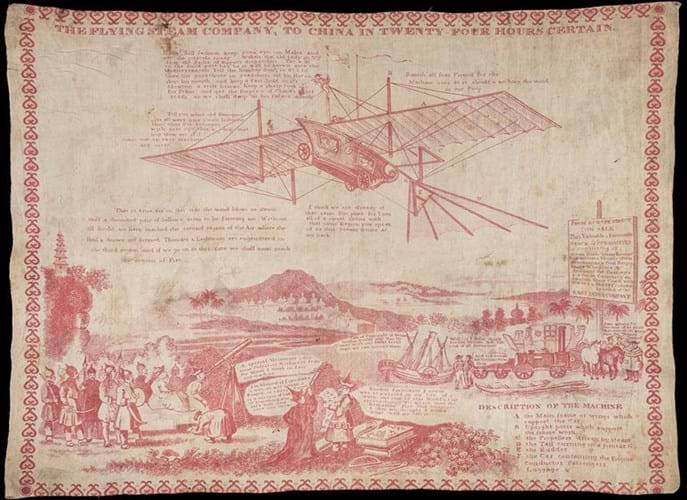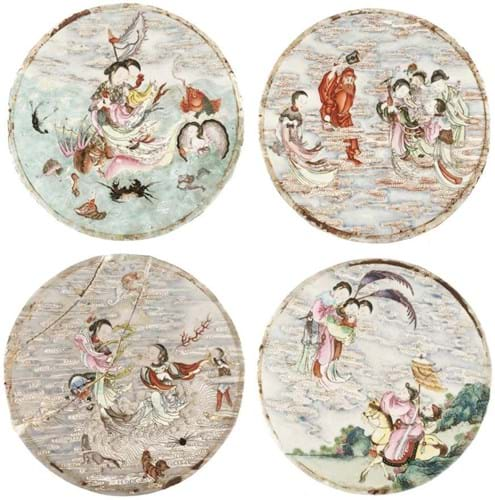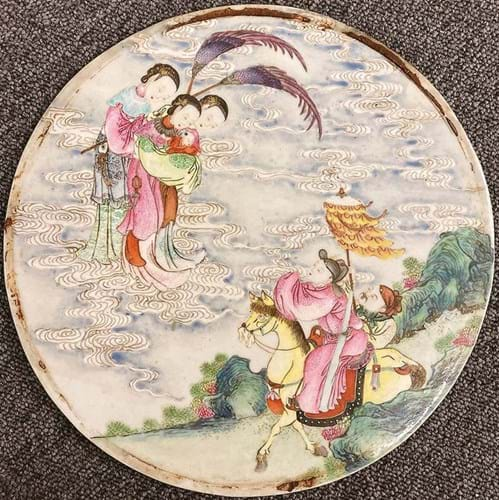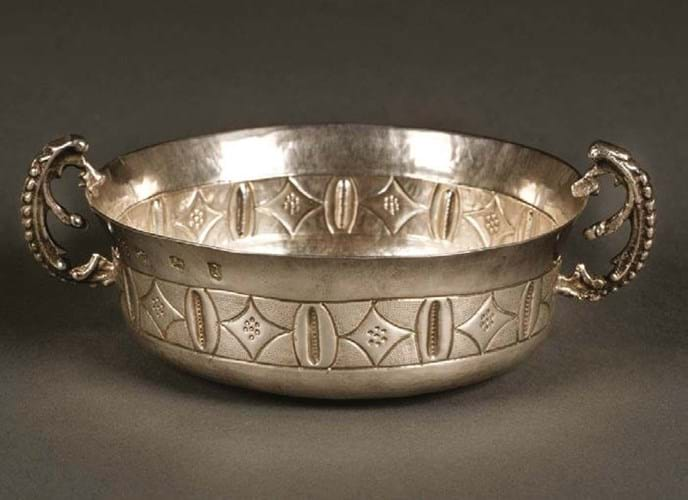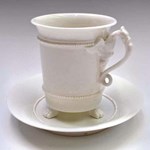Aviation pioneers William Henson (1812-88) and John Stringfellow (1799-1883) had patented their steamdriven fl ying machine, the Ariel, in 1842 and embarked on a publicity campaign that celebrated powered fl ight decades before it was actually achieved.
An extraordinary printed linen handkerchief offered at Dominic Winter (24% buyer’s premium) in South Cerney, Gloucestershire, on March 24 met the Ariel with a healthy dose of satire.
The panoramic scene of a monoplane in flight over awestruck figures is accompanied by tongue-in-cheek annotations. One figure with a telescope exclaims: “I’m blessed if I can make it out. It’s not unlike a Dragon, or a fiery Comet or a mixture of both or something else. Let’s bolt and save our necks.”
The 2ft 1in (63cm) wide handkerchief dated c.1843 is one of a handful of similar satirical prints from the period.
Another of this design is in the Science Museum collection (alongside some of Stringfellow’s original experimental models) and others have appeared at auction. One was sold by Cowan’s in Cincinnati in 2010 for $1200 while another of a diff erent design made £360 at Kerry Taylor Auctions of south London in 2016.
The Dominic Winter example (in good condition save some minor marks and three pin holes) was guided at £300-500 but found a bidder prepared to part with £4800.
In fact, Henson and Stringfellow’s design did represent a landmark of sorts – marking the transition from glider experimentation to heavier-than-air engine-driven craft – although in practice Ariel failed to fly.
A more successful model was built in 1848 which did get airborne for small distances, although China again proved beyond reach.
Better altogether
This Antiques, Antiquities, Silver & Vintage Textiles sale was not your regulation antiques and collectables event. It was better.
The array of objects on offer included a very different item in a wide-ranging section of textiles and costume: a gentleman’s doublet, typical of the Elizabethan period. Estimated at £2000-3000, it brought £11,500.
Dating from c.1580-1600 (with some later additions), it was made of gold silk velvet faded from red (a small patch of original colour remains on the right shoulder) giving way to curving sleeves of silk brocade. Fastened with Turk’s head buttons and a satin ribbon terminating in mounts of silver-gilt finial, its snug fit and belly padding created the then fashionable ‘pigeon pouter’ silhouette.
It is rare for such garments to come to the market and direct comparisons are problematic. However, another of the same period in quilted and embroidered chamois leather sold to a museum for €45,000 (£39,500) at Thierry de Maigret in Paris in 2018.
Canton coverlet
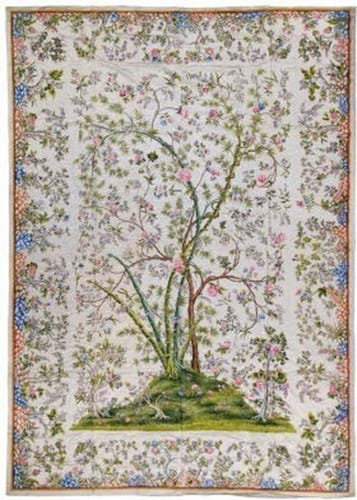
Late 18th century Cantonese painted silk panel or coverlet – £40,000 at Dominic Winter.
Two of the top three prices of the sale were paid for Chinese works of art.
Sold at £40,000 (estimate £2000-3000) was a painted silk panel or coverlet of the type made in Canton, c.1760-1800, for export to northern Europe.
Measuring 10ft 6in x 7ft 7in (3.2 x 2.31m) and formed of four loom widths of cream-coloured silk, it was decorated with a multitude of flowers and fruit around the Tree of Life motif. Key to the price was its remarkably good condition, with the colours still vibrant and the fabric robust.
A group of four 19th century circular polychrome porcelain panels came for sale by descent from the collection of Abel William Bahr (1877-1959).
A connoisseur of Chinese works of art, he was secretary of the North China branch of the Royal Asiatic Society and author in 1911 of Old Chinese Porcelain and Works of Art in China, descriptions and illustrations of articles selected from an exhibition held in Shanghai, November 1908.
These four panels (one of them broken) were probably taken from a screen telling the narrative of the immortals. They were guided at £1000-1500 but sold at £65,000 to a buyer using thesaleroom.com.
Glass sensation
However, the sensational result of the sale was achieved by a medieval work of art: two jewel-like fragments of a north European stained glass window.
One piece measuring about 14 x 11in (35 x 28cm) depicted the head of a crowned and haloed female saint; the other at 21 x 12in (53 x 32cm) showed the same subject praying before a monumental tomb.
While textiles and paintings from this period (probably early 15th century) have typically faded over time, stained glass can look much as it did when it was made.
These were an attractive proposition to many at £300-500 but the winning bid was £42,000.
Gaming ball

A 17th century ivory teetotum – £3600 at Dominic Winter.
A 17th century ivory teetotum cut with 32 numbered sides sold at £3600.
At the time, gaming balls such as this were used not just for gambling but for the lotteries that became enshrined in law through various Acts of Parliament. In his 1693 publication Some Thoughts Concerning Education, philosopher John Locke (1632-1704) suggests a 32-sided ivory ball similar to that used for the Royal Oak Lottery (introduced by Charles I to fund the carrying of water to London) could be used to teach children to read.
This example in very good condition included the clearly discernible crown motif that was added to teetotums that had been approved as ‘true and fair’.
Ivory ‘payment’
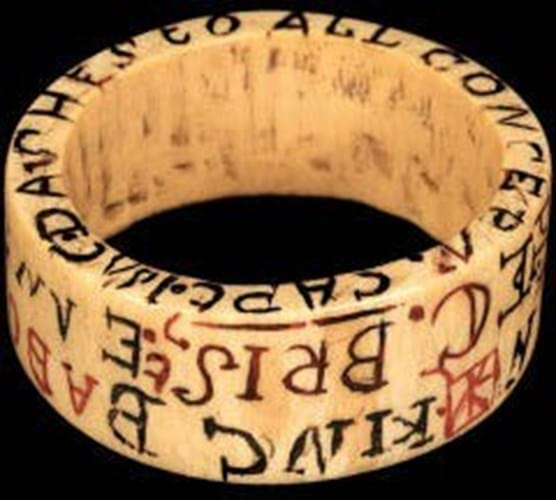
Mid-19th century ivory payment bangle – £460 at Dominic Winter.
Although their exact purpose is unknown, ivory ‘payment’ bangles were used to document financial transactions between European slave traders and their suppliers in coastal Africa – typically local tribal chiefs who were often given titles such as ‘Duke' or ‘King’ by their English-speaking customers.
There were two here from the collection of Islington dealer Jack Webb (1923-2019); one c.1850 inscribed in red Tom Nibley and another naively engraved in red and black King Baboe Best Tradesman, Bristle Emcy Chapman HR PL EC with a further inscription on the top edge Dashes To All Concern[ed] Capt. Isac.
Two similar bangles are in the collection of the International Slavery Museum, part of the Liverpool Maritime Museum. Another with an extensive calligraphic inscription recording a transaction between Captain Rob Boyd of Liverpool and Duke Cullo in 1765 sold at Lockdales in 2013 for £2900.
Under proposed legislation, remarkable objects such as these would be subject to a £250 fee before they are declared legal to sell as items ‘of outstandingly high artistic, cultural or historical value’. It would not be economical for such items as these, which sold at £400 and £460.
Ward owl
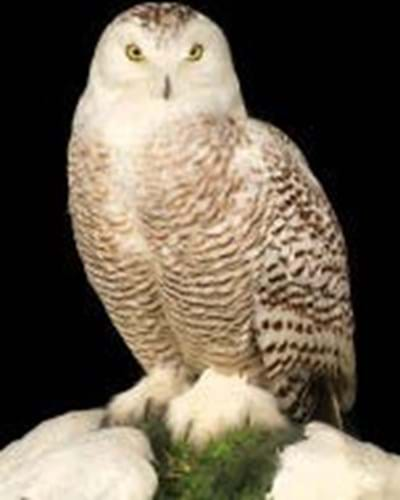
Taxidermy snowy owl by Rowland Ward, c.1920-30 – £7000 at Dominic Winter.
As well as the last elements of the Webb collection (the source of the Mary Seacole terracotta bust the firm sold for £101,000 last July, ATG No 2454), this auction included the second part of the taxidermy collection assembled by David R Wilson (1926-2020), a bookseller and secretary of the British Trust for Ornithology.
Among his choice mounts was a five-glass case with a snowy owl in a naturalist setting by Rowland Ward of Piccadilly.
Accompanying Ward’s circular ivorine brand was the label Snowy Owl (Nyctea scandiaca), Iceland. Wilson had acquired it from the estate of the aviator, ornithologist and conservationist Captain Vivian Hewitt (1888-1965). Estimated at £1000-1500, it took £7000.
Fine wine taster
Some fine silver lots included a boxed set of 12 silver tea and coffee spoons with hammered and twisted stems by Omar Ramsden, London 1938, sold at £2200. A pair of early George II Dublin silver candlesticks with shaped square bases and detachable scones with obscured marks for Barth Mosse (1734 or 1736) hammered at £2600.
However, the pick of the field was a Charles II wine taster with the two cast beaded handles and crisply embossed geometric decoration to the sides and interior of the bowl.
Engraved with initials ML and MM to the rim, it had clear marks for FW, the London leopard head and the date letter for the momentous year 1666. A great survivor, it took £5400 (estimate £1000-1500).


